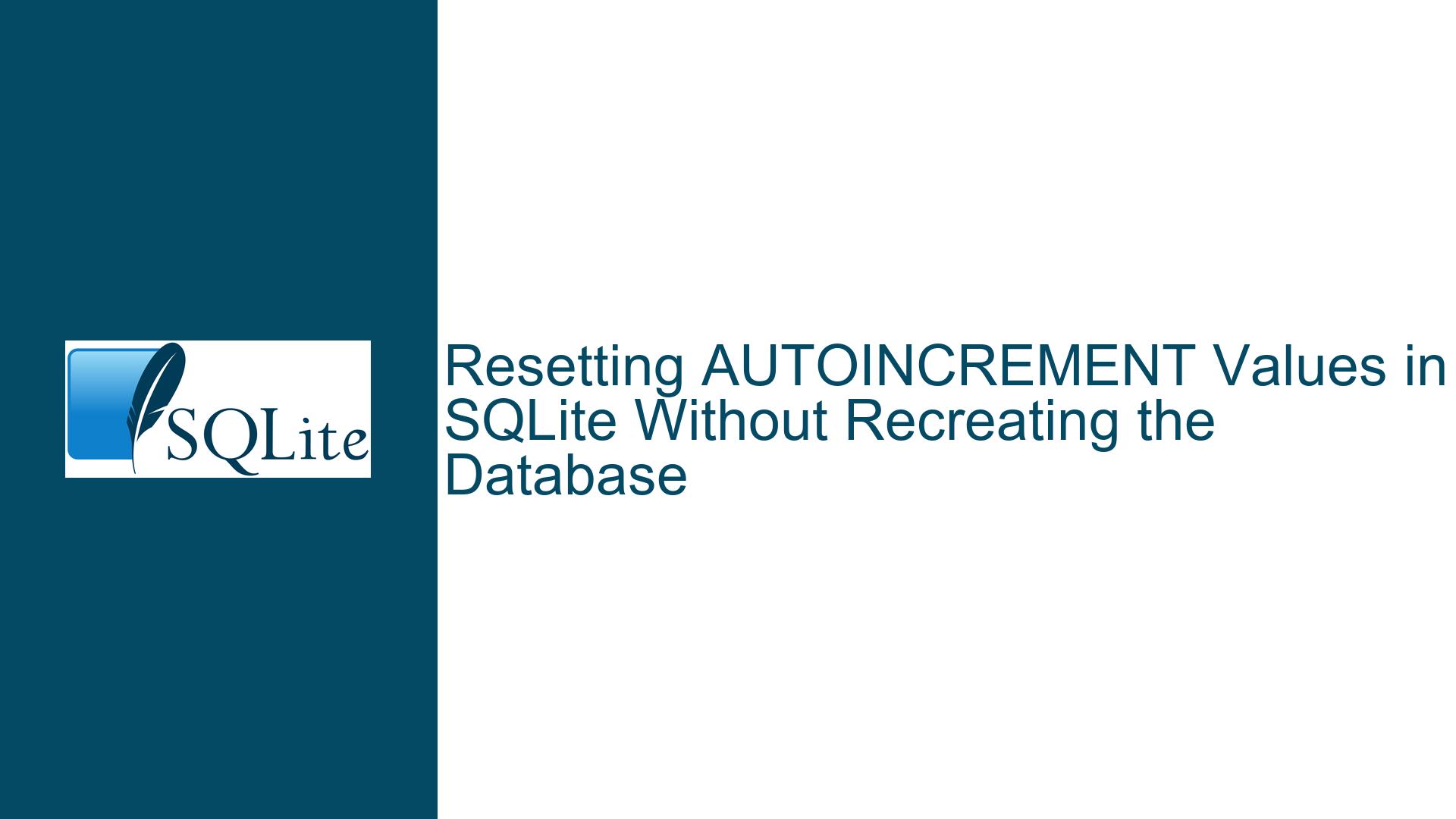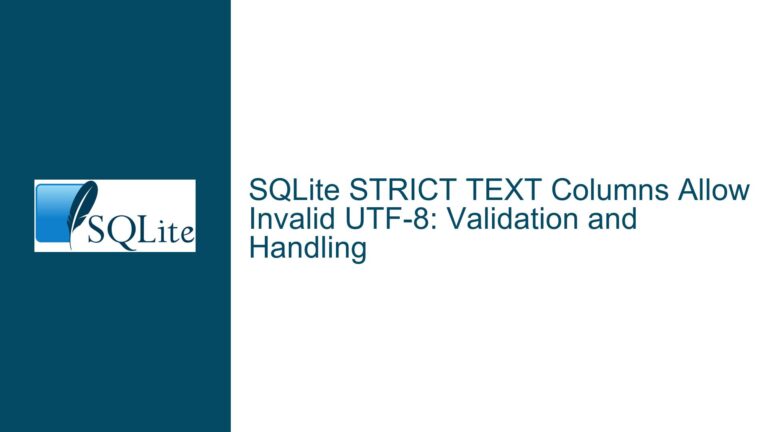Resetting AUTOINCREMENT Values in SQLite Without Recreating the Database
Understanding AUTOINCREMENT and sqlite_sequence in SQLite
SQLite is a lightweight, serverless database engine that is widely used in applications ranging from mobile apps to embedded systems. One of its key features is the ability to automatically generate unique integer identifiers for rows in a table using the AUTOINCREMENT keyword. This feature is particularly useful when you need to ensure that each row in a table has a unique identifier, even if rows are deleted or the table is truncated.
When you define a column as INTEGER PRIMARY KEY AUTOINCREMENT, SQLite ensures that each new row inserted into the table will have a unique integer value in that column. This value is automatically incremented from the highest existing value in the column. However, SQLite also maintains a special internal table called sqlite_sequence to keep track of the last used value for each AUTOINCREMENT column. This table is automatically created when the first AUTOINCREMENT column is defined in the database.
The sqlite_sequence table has two columns: name and seq. The name column stores the name of the table with the AUTOINCREMENT column, and the seq column stores the last used value for that column. When you delete rows from a table or even drop the table itself, the corresponding entry in the sqlite_sequence table is not automatically removed. This can lead to unexpected behavior when you recreate the table and start inserting new rows, as the AUTOINCREMENT values will continue from where they left off.
For example, if you have a table named users with an AUTOINCREMENT column and the last inserted row had an ID of 100, deleting all rows from the users table will not reset the AUTOINCREMENT counter. The next inserted row will have an ID of 101, even though the table is empty. This behavior is by design, as SQLite aims to ensure that AUTOINCREMENT values are always unique, even across deletions and recreations of tables.
The Impact of AUTOINCREMENT on Database Maintenance
The presence of the sqlite_sequence table and the behavior of AUTOINCREMENT columns can have significant implications for database maintenance, especially in scenarios where tables are frequently dropped and recreated. If you are working in a development environment where you need to reset the database state frequently, you may find that the AUTOINCREMENT values continue to increment, leading to large gaps in the sequence of IDs. This is not necessarily a problem in production environments, where data continuity is important, but it can be inconvenient during development or testing.
One common misconception is that dropping a table will reset the AUTOINCREMENT counter. However, as mentioned earlier, dropping a table does not remove its entry from the sqlite_sequence table. This means that if you drop a table and then recreate it with the same AUTOINCREMENT column, the new table will continue from the last used value. This behavior can be particularly problematic if you are trying to maintain a clean and predictable state in your database during development.
Another issue arises when you have multiple tables with AUTOINCREMENT columns. Each table will have its own entry in the sqlite_sequence table, and the values in this table are independent of each other. This means that resetting the AUTOINCREMENT counter for one table will not affect the counters for other tables. If you need to reset the counters for multiple tables, you will need to do so individually.
Resetting AUTOINCREMENT Values Without Recreating the Database
If you need to reset the AUTOINCREMENT counter for a table without recreating the entire database, you can do so by manually updating the sqlite_sequence table. This table is writable, and you can delete or update its entries to reset the AUTOINCREMENT counters for specific tables.
To reset the AUTOINCREMENT counter for a table, you can use the following SQL command:
DELETE FROM sqlite_sequence WHERE name = 'table_name';
This command removes the entry for the specified table from the sqlite_sequence table. The next time you insert a row into the table, SQLite will start the AUTOINCREMENT counter from 1. If the sqlite_sequence table does not exist, it means that no tables in the database have AUTOINCREMENT columns, and you do not need to worry about resetting the counters.
It is important to note that this approach only works if the table in question has an AUTOINCREMENT column. If the table does not have an AUTOINCREMENT column, or if the column is defined as INTEGER PRIMARY KEY without the AUTOINCREMENT keyword, the sqlite_sequence table will not be used, and the counter will be managed differently. In such cases, the counter is stored within the table itself, and resetting it requires a different approach, such as truncating the table or using the VACUUM command.
If you need to reset the AUTOINCREMENT counter for multiple tables, you can do so by executing the DELETE command for each table individually. Alternatively, you can truncate the entire sqlite_sequence table, which will reset the counters for all tables with AUTOINCREMENT columns:
DELETE FROM sqlite_sequence;
However, this approach should be used with caution, as it will affect all tables with AUTOINCREMENT columns in the database. If you only need to reset the counters for specific tables, it is better to use the first approach.
In some cases, you may want to reset the AUTOINCREMENT counter to a specific value rather than starting from 1. This can be done by inserting a new entry into the sqlite_sequence table with the desired value:
INSERT OR REPLACE INTO sqlite_sequence (name, seq) VALUES ('table_name', desired_value);
This command will set the AUTOINCREMENT counter for the specified table to the desired value. The next inserted row will have an ID of desired_value + 1.
Best Practices for Managing AUTOINCREMENT Values
While resetting AUTOINCREMENT values can be useful in certain scenarios, it is generally best to avoid relying on this approach in production environments. The AUTOINCREMENT feature is designed to ensure that each row in a table has a unique identifier, and resetting the counter can lead to conflicts if not done carefully. In production, it is usually better to let the AUTOINCREMENT values increment naturally, even if this results in gaps in the sequence.
However, in development or testing environments, where you may need to reset the database state frequently, resetting the AUTOINCREMENT counter can be a useful tool. To minimize the risk of conflicts, it is a good idea to reset the counter only when necessary and to ensure that all tables with AUTOINCREMENT columns are properly managed.
Another best practice is to avoid using the AUTOINCREMENT keyword unless you specifically need its behavior. In many cases, defining a column as INTEGER PRIMARY KEY without the AUTOINCREMENT keyword is sufficient. This approach still ensures that each row has a unique identifier, but it does not use the sqlite_sequence table, which can simplify database maintenance.
Finally, it is important to document any changes to the sqlite_sequence table, especially in a team environment. Resetting the AUTOINCREMENT counter can have unintended consequences if not properly communicated, so it is a good idea to keep a record of when and why the counter was reset.
Conclusion
Resetting the AUTOINCREMENT counter in SQLite can be a useful technique in certain scenarios, particularly during development or testing. However, it is important to understand the implications of this approach and to use it carefully. By manually updating the sqlite_sequence table, you can reset the AUTOINCREMENT counter for specific tables without recreating the entire database. However, this should be done with caution, especially in production environments, to avoid conflicts and ensure data integrity.
In summary, the key points to remember are:
- The
sqlite_sequencetable is used to track the last usedAUTOINCREMENTvalue for each table. - Dropping a table does not reset its
AUTOINCREMENTcounter. - You can reset the
AUTOINCREMENTcounter by deleting or updating the corresponding entry in thesqlite_sequencetable. - Avoid using the
AUTOINCREMENTkeyword unless you specifically need its behavior. - Document any changes to the
sqlite_sequencetable to avoid unintended consequences.
By following these best practices, you can effectively manage AUTOINCREMENT values in SQLite and maintain a clean and predictable database state.






